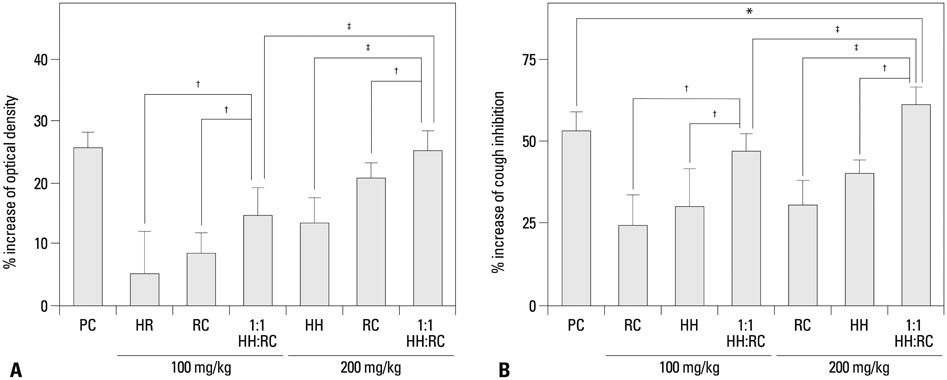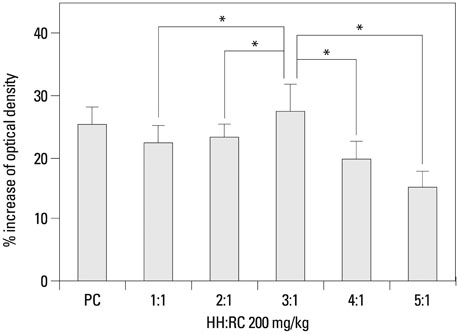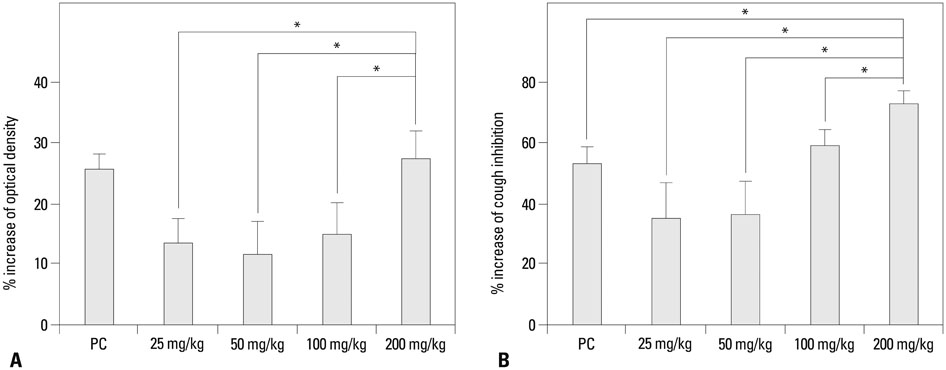Yonsei Med J.
2015 May;56(3):819-824. 10.3349/ymj.2015.56.3.819.
Expectorant and Antitussive Effect of Hedera helix and Rhizoma coptidis Extracts Mixture
- Affiliations
-
- 1Department of Otorhinolaryngology, International St. Mary's Hospital, Incheon, Korea.
- 2Research & Development Center, Ahngook Pharmacy Co. Ltd., Suwon, Korea.
- 3Natural Products Laboratory, School of Pharmacy, Sungkyunkwan University, Suwon, Korea.
- 4Department of Otorhinolaryngology, Yonsei University College of Medicine, Seoul, Korea. ydrhinol@yuhs.ac
- KMID: 2450359
- DOI: http://doi.org/10.3349/ymj.2015.56.3.819
Abstract
- PURPOSE
This study aims to investigate the additive effect of the Hedera helix (HH) and Rhizoma coptidis (RC) extracts mixture on antitussive and expectorant activities in animals.
MATERIALS AND METHODS
The expectorant assay was performed with phenol red secretion in mice trachea. Mice or guinea pigs were randomly divided into groups of 8 each, including negative and positive control groups. After gastric administration of the test extracts in mice, 2.5% phenol red solution (0.2 mL) was intraperitoneally injected. Trachea was dissected and optical density of tracheal secretion was measured. After gastric administration of the test extracts in guinea pigs, the antitussive activities were assessed using a citric acid-induced cough measurement.
RESULTS
The extracts of HH and RC significantly increased tracheal secretion and inhibited cough. The mixture of HH and RC extracts in a 1:1 concentration at a dose of 200 mg/kg showed a more potent effect on phenol red secretion (25.25+/-3.14) and cough inhibition (61.25+/-5.36) than the individual use of each extracts [phenol red secretion; HH 13.39+/-4.22 (p=0.000), RC 20.78+/-2.50 (p=0.010), cough inhibition; HH 9.89+/-4.14 (p=0.010), RC 30.25+/-7.69 (p=0.000)]. A 3:1 ratio mixture of HH to RC demonstrated an optimal expectorant effect (p<0.001), and this mixture showed expectorant and antitussive effects in a dose-dependent manner.
CONCLUSION
This study provides evidence for antitussive and expectorant effect of a 3:1 mixture of HH and RC, which may be a useful therapeutic option for respiratory diseases.
Keyword
MeSH Terms
-
Animals
Antitussive Agents/*administration & dosage/pharmacology/therapeutic use
*Behavior, Addictive
Cough/*drug therapy
Drugs, Chinese Herbal/*administration & dosage/pharmacology/therapeutic use
Ethanol
Expectorants/*administration & dosage/pharmacology/therapeutic use
Guinea Pigs
Hedera/*chemistry/metabolism
Male
Mice
Phytotherapy
Plant Extracts/*pharmacology
Plant Roots/chemistry
Trachea/drug effects/metabolism
Antitussive Agents
Drugs, Chinese Herbal
Ethanol
Expectorants
Plant Extracts
Figure
Reference
-
1. Irwin RS, Madison JM. The diagnosis and treatment of cough. N Engl J Med. 2000; 343:1715–1721.
Article2. Rubin BK. Surface properties of respiratory secretions: relationship to mucus transport. In : Baum G, editor. Cilia, mucus, and mucociliary interactions. New York: Marcel Dekker;1998. p. 317–324.3. Rubin BK. Mucolytics, expectorants, and mucokinetic medications. Respir Care. 2007; 52:859–865.4. Donaldson SH, Bennett WD, Zeman KL, Knowles MR, Tarran R, Boucher RC. Mucus clearance and lung function in cystic fibrosis with hypertonic saline. N Engl J Med. 2006; 354:241–250.
Article5. Ratjen F. Recent advances in cystic fibrosis. Paediatr Respir Rev. 2008; 9:144–148.
Article6. Holzinger F, Chenot JF. Systematic review of clinical trials assessing the effectiveness of ivy leaf (hedera helix) for acute upper respiratory tract infections. Evid Based Complement Alternat Med. 2011; 2011:382789.
Article7. Sieben A, Prenner L, Sorkalla T, Wolf A, Jakobs D, Runkel F, et al. Alpha-hederin, but not hederacoside C and hederagenin from Hedera helix, affects the binding behavior, dynamics, and regulation of beta 2-adrenergic receptors. Biochemistry. 2009; 48:3477–3482.
Article8. Wolf A, Gosens R, Meurs H, Häberlein H. Pre-treatment with α-hederin increases β-adrenoceptor mediated relaxation of airway smooth muscle. Phytomedicine. 2011; 18:214–218.
Article9. Jiangsu New Medical College. Encyclopedia of Chinese Materia Medica (Appendix). Shanghai, China: Shanghai People's Press;1977.10. Kim KR, Kim NH, Park Y, Kim JH, Lee EJ, Kim KS. Berberine suppresses interleukin-1beta-Induced MUC5AC gene expression in human airway epithelial cells. J Rhinol. 2011; 18:116–121.11. Sánchez-Mendoza ME, Castillo-Henkel C, Navarrete A. Relaxant action mechanism of berberine identified as the active principle of Argemone ochroleuca Sweet in guinea-pig tracheal smooth muscle. J Pharm Pharmacol. 2008; 60:229–236.
Article12. Engler H, Szelenyi I. Tracheal phenol red secretion, a new method for screening mucosecretolytic compounds. J Pharmacol Methods. 1984; 11:151–157.
Article13. Lin BQ, Li PB, Wang YG, Peng W, Wu Z, Su WW, et al. The expectorant activity of naringenin. Pulm Pharmacol Ther. 2008; 21:259–263.
Article14. Tanaka M, Maruyama K. Mechanisms of capsaicin- and citric-acid-induced cough reflexes in guinea pigs. J Pharmacol Sci. 2005; 99:77–82.
Article15. Cioacá C, Margineanu C, Cucu V. The saponins of Hedera helix with antibacterial activity. Pharmazie. 1978; 33:609–610.16. Trute A, Gross J, Mutschler E, Nahrstedt A. In vitro antispasmodic compounds of the dry extract obtained from Hedera helix. Planta Med. 1997; 63:125–129.
Article17. Choi UK, Kim MH, Lee NH. Optimization of antibacterial activity by Gold-Thread (Coptidis Rhizoma Franch) against Streptococcus mutans using evolutionary operation-factorial design technique. J Microbiol Biotechnol. 2007; 17:1880–1884.18. Tjong Y, Ip S, Lao L, Fong HH, Sung JJ, Berman B, et al. Analgesic effect of Coptis chinensis rhizomes (Coptidis Rhizoma) extract on rat model of irritable bowel syndrome. J Ethnopharmacol. 2011; 135:754–761.
Article19. Lu J, Wang JS, Kong LY. Anti-inflammatory effects of Huang-Lian-Jie-Du decoction, its two fractions and four typical compounds. J Ethnopharmacol. 2011; 134:911–918.
Article20. Zeng H, Liu X, Dou S, Xu W, Li N, Liu X, et al. Huang-Lian-Jie-Du-Tang exerts anti-inflammatory effects in rats through inhibition of nitric oxide production and eicosanoid biosynthesis via the lipoxygenase pathway. J Pharm Pharmacol. 2009; 61:1699–1707.
Article21. Yi J, Ye X, Wang D, He K, Yang Y, Liu X, et al. Safety evaluation of main alkaloids from Rhizoma Coptidis. J Ethnopharmacol. 2013; 145:303–310.
Article22. Timothy C, Birdsall ND, Gregory S, Kelly ND. Berberine: therapeutic potential of an alkaloid found in several medicinal plants. Altern Med Rev. 1997; 2:94–103.
- Full Text Links
- Actions
-
Cited
- CITED
-
- Close
- Share
- Similar articles
-
- Antibacterial and therapeutic effects of a combination of Coptidis rhizoma and Galla rhois extracts in piglets challenged with Campylobacter coli
- Use of Antitussive, Mucolytic Agents and Expectorants
- Apoptosis Induction Effect of Zingiberis Rhizoma Extract in Microglia BV-2 Cells
- Antiviral Activity of Hederasaponin B from Hedera helix against Enterovirus 71 Subgenotypes C3 and C4a
- Antitussives, mucolytic agents and expectorants in clinical practice




